
Concept explainers
(a)
Interpretation:
The compound from given spectra is to be identified.
Concept Introduction:
In the IR spectroscopy, change in the dipole moment produces absorption of energy. All the functional group have different absorption frequency based on which they can be differentiated. For carbonyl
Answer to Problem 21.55AP
The structure of compound is shown below.
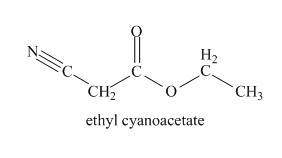
Explanation of Solution
The odd molecular mass of the compound indicates that it contains odd number of nitrogen atoms. Hydroxamate test is given by esters. So, compound contains ester group. The IR band at

Figure 1
The given compound is ethyl cyanoacetate.
(b)
Interpretation:
The compound from given spectra is to be identified.
Concept Introduction:
In the IR spectroscopy, change in the dipole moment produces absorption of energy. All the functional group have different absorption frequency based on which they can be differentiated. For carbonyl
Answer to Problem 21.55AP
The structure of given compound is shown below.
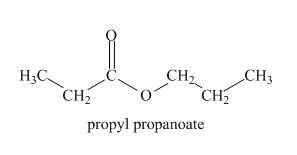
Explanation of Solution
The given compound gives IR absorption peak at

Figure 2
The given compound is propyl propanaote.
(c)
Interpretation:
The compound from given spectra is to be identified.
Concept Introduction:
In the IR spectroscopy, change in the dipole moment produces absorption of energy. All the functional group have different absorption frequency based on which they can be differentiated. For carbonyl
Answer to Problem 21.55AP
The structure of given compound is shown below.
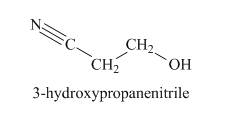
Explanation of Solution
The strong absorption peak in IR at

Figure 3
The given compound is
(d)
Interpretation:
The compound from given spectra is to be identified.
Concept Introduction:
In the IR spectroscopy, change in the dipole moment produces absorption of energy. All the functional group have different absorption frequency based on which they can be differentiated. For carbonyl
Answer to Problem 21.55AP
The structure of given compound is shown below.
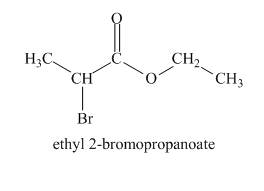
Explanation of Solution
The two molecular ion peaks at

Figure 4
The given compound is
(e)
Interpretation:
The compound from given spectra is to be identified.
Concept Introduction:
In the IR spectroscopy, change in the dipole moment produces absorption of energy. All the functional group have different absorption frequency based on which they can be differentiated. For carbonyl
Answer to Problem 21.55AP
The structure of given compound is shown below.
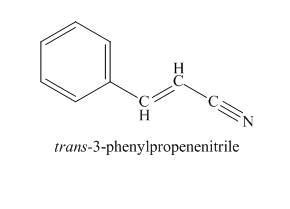
Explanation of Solution
The compound has odd molecular mass which indicates the presence of nitrogen atom. The IR absorption peak at

Figure 5
The given compound is
(f)
Interpretation:
The compound from given spectra is to be identified.
Concept Introduction:
In the IR spectroscopy, change in the dipole moment produces absorption of energy. All the functional group have different absorption frequency based on which they can be differentiated. For carbonyl
Answer to Problem 21.55AP
The structure of given compound is shown below.
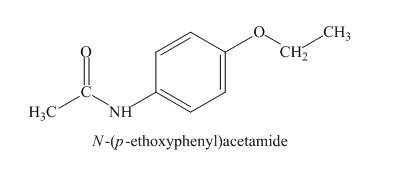
Explanation of Solution
The absorption in IR at ![]() indicates the presence of amide group and at
indicates the presence of amide group and at
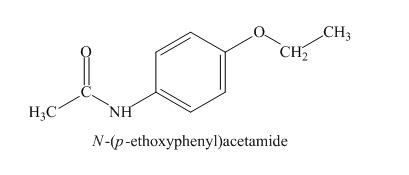
Figure 6
The given compound is
(g)
Interpretation:
The compound from given spectra is to be identified.
Concept Introduction:
In the IR spectroscopy, change in the dipole moment produces absorption of energy. All the functional group have different absorption frequency based on which they can be differentiated. For carbonyl
Answer to Problem 21.55AP
The structure of given compound is shown below.
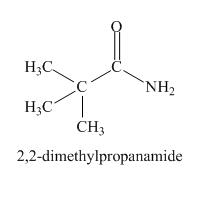
Explanation of Solution
The odd molecular mass of the compound indicates it contains nitrogen atom. The IR absorption peak at

Figure 7
The given compound is
Want to see more full solutions like this?
Chapter 21 Solutions
Organic Chemistry, Ebook And Single-course Homework Access
- How does the square root mean square velocity of gas molecules vary with temperature? Illustrate this relationship by plotting the square root mean square velocity of N2 molecules as a function of temperature from T=100 K to T=300 K.arrow_forwardDraw product B, indicating what type of reaction occurs. F3C CF3 NH2 Me O .N. + B OMearrow_forwardBenzimidazole E. State its formula. sState the differences in the formula with other benzimidazoles.arrow_forward
- Draw product A, indicating what type of reaction occurs. F3C CN CF3 K2CO3, DMSO, H₂O2 Aarrow_forward19) Which metal is most commonly used in galvanization to protect steel structures from oxidation? Lead a. b. Tin C. Nickel d. Zinc 20) The following molecule is an example of a: R₁ R2- -N-R3 a. Secondary amine b. Secondary amide c. Tertiary amine d. Tertiary amidearrow_forwardpls helparrow_forward
- pls helparrow_forward35) Complete the following equation by drawing the line the structure of the products that are formed. Please note that in some cases more than one product is possible. You must draw all possible products to recive full marks! a. ethanol + 2-propanol + H2SO4 → b. OH conc. H2SO4 CH2 H3C CH + K2Cr2O7 C. d. H3C A pressure CH3 + H2 CH Pt catalystarrow_forward21) The rate of reaction depends upon: a. the concentration and nature of reactants b. the temperature of the reaction C. whether or not a catalyst was used d. all of the above 22) A Maxwell-Boltzmann curve shows the distribution of molecular energies in a reaction system. When the temperature in this system is increased, the peak is a. higher and further to the right. b. higher and further to the left. c. lower and further to the right. d. lower and further to the left. 23) Which of the following correctly describes the reaction represented by the reaction below? CaCO3 (s) + energy → CaO (s) + CO2 (g) a. It is exothermic and the potential energy is greater in the reactants than the products. b. c. It is exothermic and the potential energy is greater in the products than the reactants. It is endothermic and the potential energy is greater in the products than the reactants. d. It is endothermic and the potential energy is equal for the products and reactants.arrow_forward

 Organic ChemistryChemistryISBN:9781305580350Author:William H. Brown, Brent L. Iverson, Eric Anslyn, Christopher S. FootePublisher:Cengage Learning
Organic ChemistryChemistryISBN:9781305580350Author:William H. Brown, Brent L. Iverson, Eric Anslyn, Christopher S. FootePublisher:Cengage Learning

